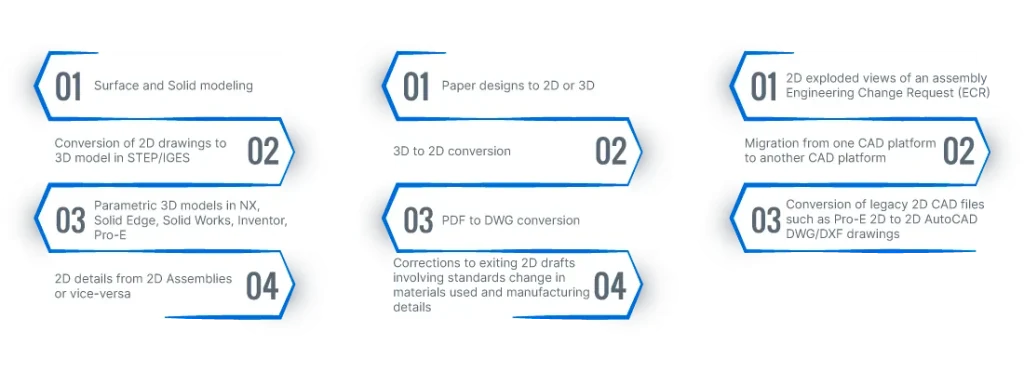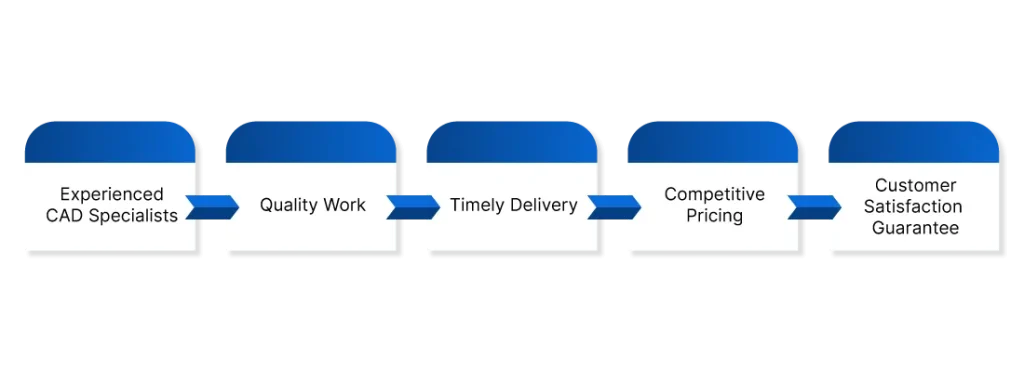Reverse Engineering CAD Engineering Services
Are you looking for high-quality and accurate 3D CAD design services for your next project? Look no further! Our team of experienced CAD specialists is here to help you bring your designs to life. We offer a wide range of CAD design services, including 3D modeling, 2D drafting, conversion, and migration services. Our CAD design process is transparent, efficient, and collaborative. We work closely with our clients to understand their requirements, and we provide regular updates throughout the design process to ensure that the final designs meet their expectations. Our process includes an initial consultation, project scope and proposal, design phase, quality control and review, and delivery and support. With our CAD design services, we can assure you of working with experienced CAD specialists who deliver quality work on time and at a competitive price.
Our CAD specialists have extensive experience in building 3D models, ranging from simple designs to complex assemblies, using a variety of software tools such as NX, Solid Edge, SolidWorks, Creo, Autodesk Inventor, CATIA, and more. We work closely with our clients to understand their requirements and provide accurate 3D models that meet their needs.
We understand the importance of accurate 2D drafting in the CAD design process, and we offer drafting services that cover all your needs. Our drafting services include converting your paper drawings and blueprints to digital formats, creating 2D drawings from 3D models, and drafting services for files from other CAD software platforms. We use industry-standard software tools such as AutoCAD and SolidWorks to create accurate and unambiguous 2D drawings that convey all the required information to the manufacturer.
We understand that many companies have legacy data in various file formats, and we offer conversion and migration services to help you move your data to a more modern platform. Our conversion and migration services can cover all your paper drawings, blueprints, and even files from other CAD software platforms. We can convert files to and from various formats, ensuring that you can work with your data in the software tools of your choice. We also offer additional services such as rendering and simulation, product design and development, reverse engineering, and more. Our team of CAD specialists has extensive experience in a wide range of industries, including aerospace, automotive, consumer products, and medical devices, among others. We pride ourselves on providing quality work, timely delivery, and competitive pricing to ensure customer satisfaction.
Conversion of 2D drawings to 3D model in STEP/IGES




Professionalism and work ethics… "The level of professionalism and work ethic you bring to the table is simply great. The fact that clicked the most is when you took complete responsibility for our product development and the outcome is exactly what we desired. Thank you Prescient."

First on our list, without doubt … “I greatly appreciate the software development work you have been doing for Level 3 Inspection for all these years. Your team’s skills and your methodical approach to perfection, coupled with your high level of professionalism, have made the road pretty smooth for us to achieve our organizational and operational integration goals. If we have to recommend a competent partner we can totally depend on, your name would be the first on our list, without a doubt. Thank you Prescient!”

They are the exception... "We've been working with Prescient Technologies for quite a few years now, and they continue to provide quality work in a timely manner for a reasonable cost. They are the exception to the two out of three rule! (Fast, High Quality or Good Price, pick two)"

There could not have been a better alternative… "It was a chance meeting with the Prescient team that set the ball rolling. Initially I was skeptical but their attitude “Together we can” inspired confidence. ”Hand-holding” by Prescient was exemplary and that was crucial for a start-up like ours. Our project in Orthopaedic navigation involved totally new objectives in as yet unexplored areas to be achieved with innovative steps in CAD domain. Few years down the line together we have added a chapter at the very edge of scientific knowledge. Thanks to Prescient our software idea has now evolved into a full-fledged market-ready product. Today I am convinced that there could not have been a better alternative."

Professionalism and work ethics… "The level of professionalism and work ethic you bring to the table is simply great. The fact that clicked the most is when you took complete responsibility for our product development and the outcome is exactly what we desired. Thank you Prescient."
Our CAD design services are suitable for a wide range of industries, including manufacturing, automotive, aerospace, defense, architecture, and many others. We have experience in creating 3D models and 2D drawings for various products, components, and systems.
Our team of CAD specialists has expertise in using a variety of software tools, including NX, Solid Edge, SolidWorks, Creo, Autodesk Inventor, CATIA, and more. We can work with the software tools of your choice.
Yes, we offer conversion and migration services that can cover all your paper drawings, blueprints, and even files from other CAD software platforms. We can convert your paper drawings or blueprints into 3D models and 2D drawings that are accurate and high quality.
The timeline for a CAD design project depends on the complexity of the project, the scope of work, and the number of revisions required. We will provide you with a timeline estimate during the initial consultation phase.
Yes, we encourage our clients to provide feedback and request changes or revisions to the designs throughout the design process. We will work closely with you to ensure that the final designs meet your requirements and expectations.
We have a rigorous quality control and review process that includes multiple checks and tests to ensure the accuracy and quality of the CAD designs. Our team of CAD specialists also has extensive experience in creating 3D models and 2D drawings that are precise and reliable.
Yes, we offer CAD design services for both prototypes and small production runs. Our team can work with you to design and create 3D models and 2D drawings that are optimized for manufacturing and production.
Yes, we are committed to protecting the confidentiality and intellectual property of our clients. We are happy to sign an NDA or any other legal agreements that are required to ensure the protection of your information and designs.
We can deliver the final CAD designs in a variety of file formats, including IGES, STEP, STL, PDF, and others. We will work with you to determine the best file format for your specific needs and requirements.
Your PLM system should evolve with your business not trap it in place. Yet countless manufacturers discover this truth too late, when a seemingly simple software upgrade becomes a six-month ordeal requiring extensive code rewrites and threatening business continuity. The difference between configurable and customized PLM isn’t just technical semantics. It’s the difference between a system that grows with you and one that eventually holds you hostage. The Upgrade Lock-in Problem: A Growing Crisis Every year, PLM vendors release new versions packed with enhanced capabilities, security patches, and modern integrations. Your competitors adopt these improvements quickly, gaining efficiency advantages. Meanwhile, your team receives the dreaded news: “Our customizations aren’t compatible with the new version. Upgrading will take 8-12 months and cost $500,000.” This scenario plays out across manufacturing with alarming frequency. Companies invest heavily in PLM systems, customize them extensively to meet specific requirements, and then discover they’ve created upgrade barriers that grow more expensive with each passing version. The financial impact compounds over time: Beyond dollars, upgrade lock-in creates operational paralysis. Teams hesitate to modify processes because changes might complicate future upgrades. Innovation stalls. Business agility suffers. The system that should enable growth becomes a constraint. Why Heavy Customization Creates Technical Debt Understanding why PLM customization leads to upgrade lock-in req uires examining how customizations interact with core system architecture. When vendors release new versions, they modify underlying code, databases, and APIs. Extensive customizations built on the old foundation often break catastrophically. Core modifications are the biggest culprit. When customizations alter fundamental PLM objects, workflows, or data models, they create fragile dependencies. A vendor’s structural change can cascade through dozens of custom modules, requiring complete rewrites. Custom code lacks vendor support. During upgrades, vendors test and validate their standard functionality. Your custom code? That’s entirely your responsibility to fix, test, and validate. This burden grows exponentially with customization complexity. Integration points multiply maintenance. Custom integrations with ERP, CAD, and other systems often rely on specific API versions. Vendor upgrades frequently deprecate old APIs, forcing integration rewrites alongside core customization updates. Documentation gaps compound problems. Custom code written years ago by departed developers becomes a black box. Without proper documentation, even simple customization updates consume weeks of reverse-engineering effort during PLM implementation upgrades. The irony? Most heavy customizations address requirements that configurable solutions could have handled with proper PLM implementation planning. Configurable PLM: Built-in Flexibility Without the Baggage Modern configurable PLM platforms deliver extensive flexibility through vendor-supported mechanisms designed to survive upgrades. Understanding these capabilities transforms how manufacturers approach PLM customization decisions. Configuration tools provide powerful adaptation: These configuration capabilities handle 80-90% of typical “customization” requirements. The critical difference? Configurations remain vendor-supported through upgrades. The vendor tests configuration compatibility, provides migration tools, and ensures configurations survive version transitions. The upgrade advantage is transformative: Strategic PLM implementation leverages configuration first, reserving true customization for genuinely unique requirements that configuration cannot address. The Smart Customization Strategy: When and How to Customize Eliminating all PLM customization isn’t realistic or advisable. Some requirements genuinely exceed configuration capabilities. The key is distinguishing necessary customization from premature customization and implementing it with upgrade survivability in mind. Reserve customization for these scenarios: When customization is necessary, follow upgrade-friendly principles: Build through extensibility frameworks. Modern PLM platforms provide custom development frameworks designed for upgrade compatibility. These frameworks offer hooks, events, and APIs that remain stable across versions, allowing customizations to survive upgrades with minimal modification. Maintain strict separation from core code. Never modify vendor-supplied objects, workflows, or data models directly. Build separate custom modules that interact with the core through supported interfaces. This isolation prevents vendor changes from breaking your customizations. Document obsessively with future developers in mind. Every customization needs comprehensive documentation explaining business requirements, technical implementation, dependencies, and testing procedures. Future upgrade teams will thank you. Version control everything. Maintain complete revision history of all custom code, configurations, and documentation. This enables rapid assessment of what changed between versions and expedites upgrade testing. Plan upgrade testing from day one. Design customizations with testability in mind. Maintain automated test suites covering all custom functionality. This dramatically reduces validation time during actual upgrades. Thoughtful PLM customization balances current needs with long-term flexibility, ensuring your investment supports rather than constrains future growth. Implementation Strategy: Getting It Right From the Start The most effective time to prevent upgrade lock-in is during initial PLM implementation. Decisions made during deployment establish patterns that persist for years. Following a configuration-first methodology protects long-term flexibility while meeting immediate requirements. Phase 1: Requirements Analysis with Configuration Mapping Before writing a single line of custom code, exhaustively explore configuration capabilities: Many “must-have customizations” evaporate when configuration capabilities are fully understood and business processes adapt modestly. Phase 2: Configuration-First Implementation Implement all configuration-addressable requirements first: This approach delivers immediate value while maintaining upgrade flexibility. Teams gain experience with configuration tools, often discovering additional standard solutions for perceived customization needs. Phase 3: Selective, Strategic Customization For requirements genuinely exceeding configuration capabilities, implement minimal, focused customizations: Phase 4: Ongoing Governance Establish rigorous change management processes: Strong governance prevents customization creep that gradually recreates upgrade lock-in despite initial discipline. Moving Forward: Breaking Free from Lock-in If you’re already locked into a heavily customized PLM system, the path forward requires honest assessment and strategic action. Continuing with the status quo only deepens the problem as technical debt compounds with each postponed upgrade. Assessment starts with inventory: Remediation follows multiple paths: Some organizations undertake phased “de-customization” projects, systematically replacing custom code with vendor-supported configurations. Others time major customization reduction with necessary upgrades, combining upgrade and modernization efforts. Still others implement parallel configurable systems, gradually migrating from legacy customized environments. The right approach depends on your specific situation, but action beats inaction. Every year maintaining heavily customized systems increases future migration costs while competitors advance with modern, flexible platforms. Take Control of Your PLM Future PLM customization and PLM implementation decisions made today determine your flexibility tomorrow. The difference between configurable and customized approaches isn’t just technical it’s strategic. Configurable systems adapt
Read MorePicture this: It’s 3 PM on a Friday, and your engineering team just discovered a critical dimensional error in a component that’s already been released to production. What follows is a familiar cascade emergency meetings, rushed paperwork, production line adjustments, and an engineering change order that will consume countless hours and thousands of dollars. Sound familiar? You’re not alone. The Hidden Cost of Engineering Change Orders Engineering change orders represent one of the most significant yet underestimated drains on manufacturing efficiency. Industry data suggests that ECOs cost manufacturers between $5,000 to $50,000 per change, depending on complexity and timing. But the real impact goes far beyond the immediate financial hit. Every ECO triggers a domino effect: Through strategic CAD software development, these workflows can be dramatically improved. Late-stage ECOs are particularly painful. Consider the cost escalation: Post-production changes can derail entire product launches and damage customer relationships permanently. Why Traditional Processes Amplify the Problem The root cause isn’t careless engineering it’s process limitations. Most manufacturers rely on manual design validation, where human reviewers check CAD models against specifications, standards, and compatibility requirements. This approach has three critical weaknesses: Human error is inevitable. Even experienced engineers miss issues when reviewing complex assemblies with hundreds of components and thousands of dimensional relationships. Common failure points include: Validation happens too late. Traditional workflows perform comprehensive checks only at formal review gates. By then, the design has progressed significantly, making changes exponentially more expensive and time-consuming. Implementing design automation addresses this fundamental timing issue. Knowledge silos create blind spots. Manufacturing constraints, supplier capabilities, and historical issue patterns often live in individual team members’ heads rather than in systematic validation rules. When that expertise isn’t available during design, problems slip through. The result? ECO rates of 15-25% on new product introductions are common across the industry, with each change adding weeks to development timelines and straining resources that could be driving innovation instead. The Automation Advantage: Shifting Left on Quality Automated validation fundamentally changes this equation by embedding intelligence directly into the design environment. Rather than catching errors during reviews, automated systems prevent them from being created in the first place. Modern automation solutions validate designs continuously in real-time. As engineers model components, automated rules check: It’s like having an expert manufacturing engineer reviewing every design decision the moment it’s made. This “shift left” approach catching issues earlier in the development cycle delivers dramatic ECO reduction. Organizations implementing comprehensive automation report impressive results: Building Your Implementation Roadmap Successfully deploying automated validation requires strategic planning, not just technology installation. Effective CAD software development creates systems that integrate seamlessly with existing workflows. Here’s a practical framework for manufacturers ready to reduce ECO costs: Phase 1: Identify Your Pain Points Start by analysing your ECO data from the past 12-24 months. What patterns emerge? Common culprits include tolerance stack-up issues, standard part violations, manufacturability oversights, and supplier compatibility problems. Understanding your specific failure modes allows you to prioritise automated validation rules that deliver immediate value. Phase 2: Codify Tribal Knowledge Your experienced engineers carry invaluable design intelligence. Capture this expertise through structured interviews and workflow analysis. Which design decisions consistently cause problems? What manufacturing constraints must designs accommodate? What supplier limitations need consideration? This knowledge becomes the foundation for your automated validation rules. Phase 3: Implement Progressively Avoid the “big bang” approach. Start with automated checks for your highest-impact ECO categories, perhaps dimensional validation or standard part compliance. Let your team adapt to real-time validation feedback before expanding to additional rule sets. This staged approach builds confidence and allows you to refine your strategy based on real-world performance. Design automation implementation should always be incremental and measured. Phase 4: Integrate Across the Ecosystem Effective automation extends beyond the CAD environment. Connect your automated validation to product lifecycle management systems, ERP platforms, and supplier databases. When your validation system can verify real-time material availability, check against current supplier capabilities, and validate against manufacturing equipment specifications, you eliminate entire categories of potential ECOs. The key is creating an integrated ecosystem where automation touches every aspect of product development from initial concept through manufacturing release. This holistic approach ensures consistency and catches issues that might slip through isolated validation checks. Phase 5: Measure and Optimize Track your ECO metrics religiously not just volume, but timing, root causes, and costs. Monitor how many issues your automation catches versus human review. Identify patterns in the problems that still slip through and expand your rule sets accordingly. The most successful implementations treat automation as a continuously improving system rather than a one-time deployment, demonstrating clear return on investment. Professional CAD software development ensures scalability as your needs evolve. Real-World Impact: Beyond ECO Reduction When you significantly reduce engineering change orders through automated validation, the benefits extend far beyond avoiding change order costs: Operational Benefits: Strategic Advantages: Perhaps most importantly, engineering workflow optimization through automation creates a cultural shift. When engineers receive immediate feedback on design decisions rather than learning about problems weeks later in formal reviews, they develop stronger intuition about manufacturability and design excellence. The automation investment becomes a teaching tool that elevates your team’s capabilities over time. Strategic Considerations for Implementation Implementing effective automated validation requires more than off-the-shelf solutions. The most successful manufacturers invest in custom solutions that address their specific challenges, industry requirements, and manufacturing capabilities. Sophisticated design automation platforms must align with your unique operational context. Consider your unique design environment. Do you work with complex assemblies requiring interference checking? Do industry standards demand specific validation protocols? Does your supply chain have particular constraints that designs must accommodate? These factors should shape your implementation strategy. Integration capabilities matter tremendously. Your automation platform needs to communicate seamlessly with existing PLM systems, CAD tools, ERP platforms, and manufacturing execution systems. Custom development ensures these integrations work reliably rather than forcing workarounds with incompatible systems. Scalability is equally critical. As your product portfolio grows and design complexity increases, your automation infrastructure must scale accordingly. Investing in robust CAD software development from
Read MoreHave you ever had to halt production because a critical supplier failed to deliver on time? Many manufacturers struggle with broken links in the supply chain, especially when their digital tools can’t adapt fast enough. In today’s uncertain environment, it’s no longer enough to have a Product Lifecycle Management (PLM) system that just tracks internal workflows. You need one that connects, adapts, and responds across your entire supply network. This is where PLM customization helps. It extends the core capabilities of your PLM system to create resilient, adaptable supply chains and collaborative ecosystems across suppliers, design teams, and manufacturing partners. Why Standard PLM Isn’t Enough for Modern Supply Chains Traditional PLM systems are mostly built to serve internal engineering teams. They focus on managing product data, revisions, and approvals. But supply chains today involve global partners, suppliers, and external contributors. Static systems can’t handle this complexity. PLM needs to evolve from being a data repository to becoming a connected collaboration backbone. That transformation begins with customisation. How PLM Customization Supports Supply Chain Resilience 1. Design for Disruption Disruptions be it a pandemic, conflict, or material shortage can break traditional supply chains. Companies with custom PLM workflows can build alternative sourcing models and simulate supply risks before they cause damage. A customised PLM system can: According to Wired (2023), 75% of manufacturers plan to invest in digital resilience tools after recent global supply chain shocks. 2. Real-Time Supplier Collaboration Your suppliers shouldn’t be left out of your product lifecycle. A customised PLM platform can offer secure access to selected data, letting vendors contribute at earlier stages of design and manufacturing. Key features include: With PLM supplier collaboration, you reduce cycle time and improve component quality before a part reaches production. 3. Faster Workflows with Automation Manual approvals and data updates often cause delays. PLM workflow automation streamlines repetitive tasks by automatically routing files, notifying users, and logging changes. Common use cases include: This level of automation brings greater control and reduces human error. TechVersions reports that PLM automation can cut product development time by up to 35% (2024). Connecting the Digital Thread Beyond the Organisation The digital thread is the flow of data that connects every stage of your product lifecycle. PLM is a core part of this, but without customization, the thread often breaks when external partners come into play. PLM customization helps by: By building an extended thread, you ensure that everyone internal or external is working from the same up-to-date product data. Why Adaptability Needs to Be Built Into PLM Resilience is not just about reacting to crises it’s about adapting quickly. An adaptable PLM system allows you to: This flexibility makes it easier to meet customer demands, enter new markets, and respond to emerging challenges without rebuilding your system from scratch. Signs You Should Extend Your PLM Capabilities You might need PLM customization if: These issues become business risks as supply chains get more complex. A generic PLM setup cannot handle such variability. A customised one can. What Prescient Technologies Offers Prescient Technologies helps manufacturers build smarter PLM environments that go beyond engineering silos. We specialise in: Our team has delivered custom PLM solutions for leading global manufacturers across industries, making their product and supply data more connected, secure, and adaptable. Key Takeaways Ready to Extend Your PLM Capabilities? If your organisation is looking to improve product visibility, strengthen supplier networks, and build more adaptable operations, it’s time to extend your PLM system. 👉 Talk to Prescient Technologies about how PLM customization can make your supply chain more resilient, collaborative, and future-ready.Contact us to get started.
Read More